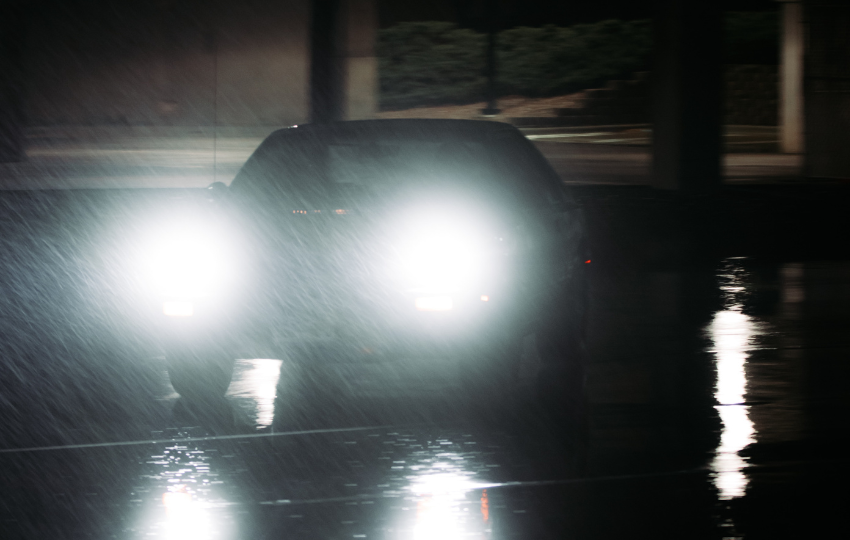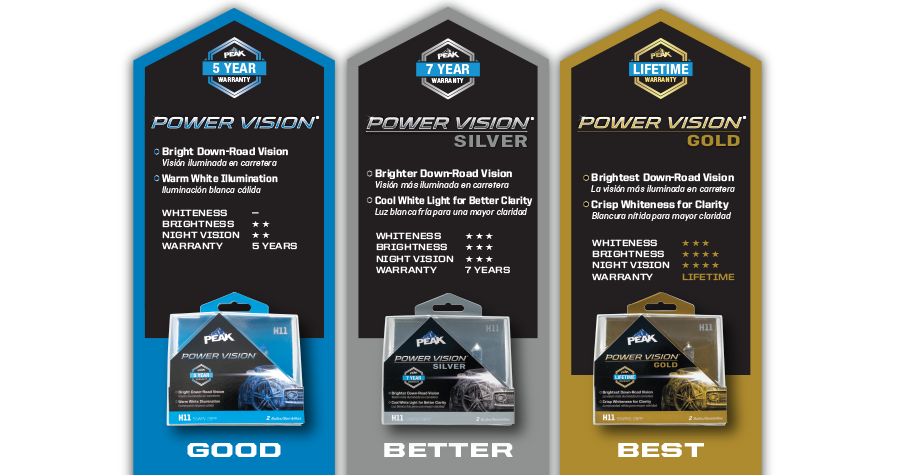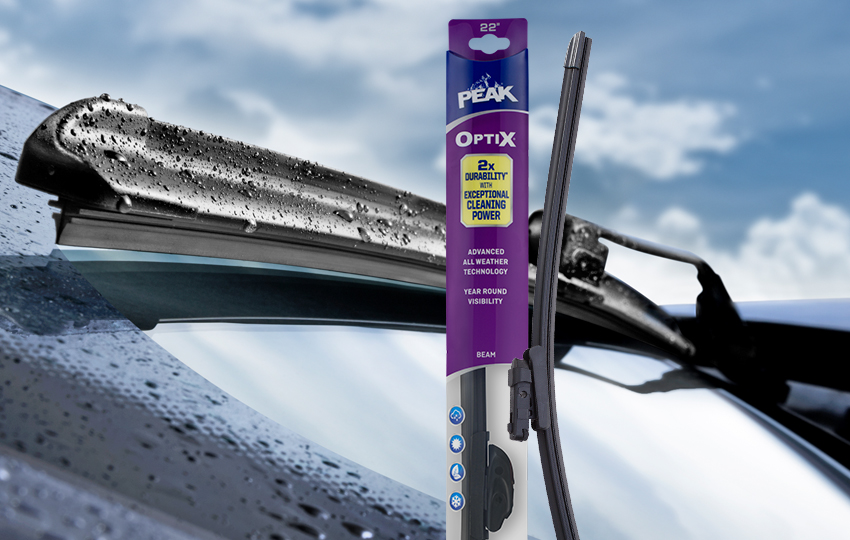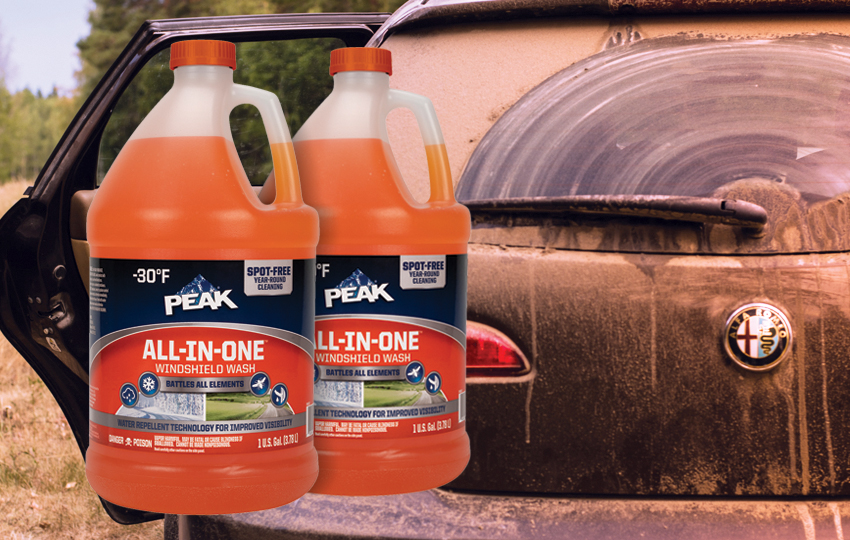
How To Improve Car Safety and Visibility with Headlights
- Vehicle Maintenance
- PEAK
- November 14, 2022
Learn how to maintain these crucial components, when and how to replace them, and what features to look for.
Last year was not a good one for traffic accidents. The National Highway Traffic Safety Administration estimates that 42,915 people died in motor vehicle traffic crashes last year. That’s a 10.5% increase from 2020, when fatalities hit 38,824, and the highest number of traffic deaths since 2005.
“You’re three times more likely to have an accident at night than in daytime.” -Car and Driver
Things get even more grim when talking about night driving. While we only drive at night a fourth of the time, the National Safety Council (NSC) warns that 50% of traffic deaths happen at night. And compromised vision is a huge reason why. According to the NSC, “Depth perception, color recognition and peripheral vision can be compromised in the dark, and the glare of headlights from an oncoming vehicle can temporarily blind a driver.”
Even at their best, traditional headlights with the high beams on can only provide about 500 feet of visibility (half that with normal beams). That means you’ve got less time to react when something crosses your path at night. And as the days get shorter and darker, you’ll find yourself driving in the dark more often. Add rain into the equation, and well, you get the picture.
Obviously, drivers can’t always avoid hitting the road at night, or in the rain. But there is something you can do to stay safe on the roads, day or night, rain, or shine. When maintained properly, and chosen wisely, three often overlooked components can help you stay safe on the road: headlights, wiper blades, and windshield wash.
Learn how to improve visibility, reliability, and safety with performance you can see.
Headlights
Most of us take our headlights for granted, and rarely give them a thought — until it’s rainy, or foggy, or one goes out and suddenly we can’t see down the road. It’s not fun to think about, but the older we get, the more important it is to have excellent headlights. Our night vision declines as we age, which means we have less ability to see well in low-light conditions. As the NSC points out, a 50-year-old driver may need twice as much light to see as well as a 30-year-old. After age 60, driving visibility continues to slide thanks to cataracts and a host of common degenerative eye diseases.
Headlight Maintenance and Best Practices
No matter your age, or the caliber of your night vision, it’s important to maintain your headlights so they provide the best possible visibility. The brightness of your headlights can be reduced if they’re covered in grime — not to mention, ice or snow. Wipe your headlights down regularly to maintain peak visibility.
Tips for Driving Safely at Night from NSC
- Aim your headlights correctly
- Keep your headlights clean
- Dim your dashboard
- Look away from oncoming lights
- If you wear glasses, make sure they're anti-reflective
- Clean your windshield to eliminate streaks
- Slow down to compensate for limited visibility and reduced stopping time


Do Your Headlights Look Cloudy, Hazy or Yellow?
Long-term exposure to the sun’s UV rays can damage a headlamp’s plastic coating and cause it to appear discolored or cloudy. Beyond affecting the appearance of your car, cloudy headlights are downright dangerous. According to AAA research, cloudy headlights produce only 20% of the light created by new headlights. This reduced illumination decreases your visibility significantly and can be especially dangerous on dark roads and poorly lit streets.
According to Car and Driver, “If the plastic headlight lenses are yellowed to the point where it’s hard to see the bulbs, it’s time to either restore or replace the headlamps.” And while some DIYers opt to remove the fog with toothpaste, baking soda and elbow grease, Car and Driver points out, “If you want to get the greatest improvement in lighting power, AAA recommends skipping restoration and opting for headlight replacement.”
Aim Your Headlights Correctly for Safer Night Driving
“Misaligned lights can reduce your reaction time to zero.” -Popular Mechanics
Many drivers don’t realize that a car’s headlights can become misaligned over time due to an accident or even a minor bump — or when you’re replacing the bulb. Misaligned headlights can reduce your visibility considerably when you’re driving at night. And while an auto shop or dealer can realign your headlights for you, DIYers are also capable of tackling the task at home. You’ll find ample instructional videos and how-to articles online, but we like Popular Mechanics’ “quick-and-dirty guide” to adjusting your headlights.
When Should You Replace Your Headlights?
Headlights can last anywhere from 500 to 30,000 hours, depending on the type of bulb. That said, there are several tell-tale signs that it’s time to replace your headlights. If you notice that one bulb is out, or failing in any way, the other one will follow soon after. That’s why it’s always best to replace both headlights at the same time.
The following signs mean that it’s time for a new set of headlights:
• Headlights appear dim or hazy
• Headlights flicker
• High beams won’t turn on
• One headlight is out
• The fuse blows out (more than once)
Technology has come a long way over the past few decades. For safer driving at night and in extreme weather, it’s a good idea to consider an upgrade before you absolutely need one. According to one national auto shop, “Changing out your old halogen headlights for newer models can provide 30 percent brighter light and up to 25 percent more down-road visibility.”
Headlight Lifespan
Halogen: 500 - 1,000 hours
HID: 2,000 hours
LED: 30,000 hours
What To Look for in New Headlights
A good set of high quality headlights should help you feel comfortable driving at night. They should provide optimal down-road visibility so you can see further, give you a wide field of vision and perform well in any kind of weather. They should also have a long life — and an excellent warranty for peace of mind.
Before you start shopping for replacement headlights, you’ll need to know about the different types of bulbs that are available. The majority of cars on the road come with halogen bulbs, which are generally less expensive and easier to install than some of the more recent technology.
Why is my headlight out?
Here are the most common reasons why your headlight may be out:
Age
How long have you been driving with the same bulbs? If it’s been more than 500 - 1,000 hours (for halogen bulbs), it’s time for a replacement.
Extreme Temperature Swings
Excessive changes in temperature (either hot or cold) can damage the delicate filament in your bulb.
Cracks in the Housing
Moisture, humidity and wetness that creeps in from a crack in the bulb housing can damage your halogen lights.
Different Types of Headlight Bulbs
Round, sealed-beam glass headlights with incandescent bulbs were standard on all cars up until 1975, and swapping them out was a simple matter of taking the whole thing out and putting a new one in. These days, there are several different types of bulbs that may be in your headlights, and the first step is figuring out which one you’ve got.
-
Halogen
Halogen lights were introduced in the 1970s and are the most common types of headlights on the road today. They contain a filament (like you’ll find in an incandescent light bulb) that’s enclosed in a capsule filled with halogen gas. These bulbs are inexpensive and easy to install. They emit a slightly yellowish warm light.
-
HID
Introduced on high-end cars in the early ‘90s, high-intensity discharge (HID) headlights are gas-discharge lights that emit a brighter light than halogens. They’re more energy efficient and longer lasting, though they can be more difficult to install and more expensive. Unlike halogen lights, many HIDs have a warm-up period until they reach their brightest. You’ll need a conversion kit if you plan on upgrading halogen lights to HID.
-
LED
Introduced in the 1990s, LED headlights are the longest lasting type of headlight bulb. These charged, glowing electron lights can fit into tight spaces, which makes them more flexible for auto designers who want to create sleeker headlight designs. LEDs are extremely energy efficient and run cool, hence their impressive lifespan. They produce a bright white light that can reach up to a mile down the road.
While technology continues to evolve toward brighter, longer-lasting headlights, most vehicles on the road today are equipped with halogen headlights — which are far superior to the halogen headlights from days of old. The easiest way to determine what type of headlights you have is to check your vehicle owner’s manual. Look in the section near the back where you’ll find dimensions, statistics, and manufacturer-recommended replacement parts. Lost your manual? There’s always Google.
How To Replace Halogen Headlight Bulbs
Most new cars are sold with standard halogen bulbs, and many drivers opt to upgrade to a superior halogen bulb that provides better visibility when they replace them. Installing halogen headlight bulbs is usually fairly simple and straightforward, though it’s always a good idea to consult your owner’s manual. Replacing a damaged headlight housing or lens can be a bit more involved.
To replace a halogen headlight bulb:
- Turn your car off and take the keys out of the ignition.
- Put on rubber gloves.
- Pop the hood and find the headlight holder at the front of the car.
- Remove the headlight connections at the back of the headlight housing. Look for three wires attached to the base of the bulb. Push down the clip or cap that holds them in place.
- Tip: Mark where you removed the wiring with masking tape, so you know exactly how and where to plug it back in.
- Unscrew the old bulb. Be careful not to confuse the beam adjustment screws with the retaining screws, which are generally smaller.
- Screw in the new bulb without touching the glass of the bulb.
New bulb not working? You may have an issue with the fuses and the wiring.
PEAK® POWER VISION GOLD HEADLIGHTS — The Last Bulb You’ll Ever Buy
PEAK’s premium high-performance halogen headlights feature a high energy light pattern, increased output, and whiter light. This creates a brighter light that illuminates more of the road for better visibility and safer driving at night. How? High-performance tungsten filaments, customized gas mixtures and a proprietary optical coating. Here’s what that looks like:
1. Proprietary Optical Coating: Produces a whiter light than a standard lamp.
2. Power Vision Window: Increases light output to produce exceptional nighttime illumination.
3. Precision Coiling: High output boosted tungsten lamp filament produces a high energy light pattern.
4. Customized Gas Mixtures: Precision mixed halogen cycle gasses result in high output performance.
Better yet, PEAK® POWER VISION GOLD lamps are guaranteed for life. That means that this is the last bulb you’ll ever buy. Safer driving at night starts with your headlights. The sooner you’re able to see an object on the road, the quicker you can react. Improve visibility, reliability and safety with performance you can see — backed by a lifetime warranty.


learn more about how to improve car safety and visibility
-

How To Improve Car Safety and Visibility with Wiper Blades
Learn how to maintain these crucial components, when and how to replace them, and what features to look for.
Learn More
-

How To Improve Car Safety and Visibility with Windshield Wash
Learn how to maintain these crucial components, when and how to replace them, and what features to look for.
Learn More
